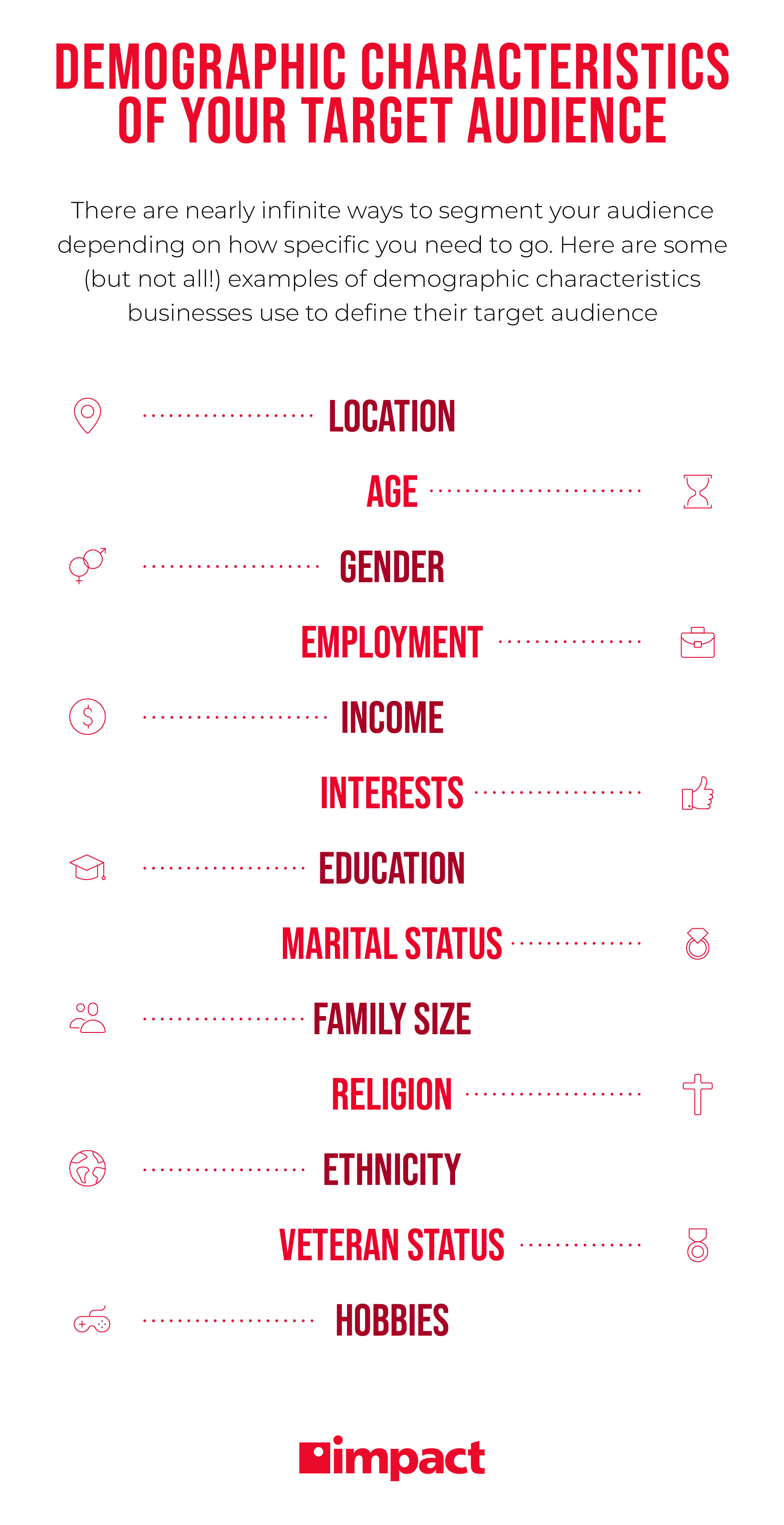As of 2024, there are over 5 billion people using at least one form of social media across the globe. This massive population is just one of the reasons that social media has become a playground for brand marketing and advertising. However, with this volume of users, it’s vital that organizations focus on connecting with the right users. This is the process of finding your social media target audience.
Finding your target audience on social media allows you to use catered messaging that’s much more tailored based on their likes, interests, values, and other demographics like age, and income range.
By defining your target audience on social media, you’ll know who you’re marketing toward, which in turn will help you create stronger, more resonant, and more engaging campaigns overall. Let’s explore how brands go about defining a target audience on social media below.
For more information on how modern brands use marketing to establish stronger connections with their target audience, watch Impact’s webinar, Attract, Engage, Stand Out—Building Effective Marketing Campaigns.
How to Identify Your Target Audience
Marketing teams waste nearly $40 billion a year on ads and campaigns that don’t effectively engage with their target audiences. Oftentimes, this failure to engage your audience stems from using a blanket approach instead of drilling into the details of the individuals who comprise your audience.
A “target audience” is a group of consumers characterized by businesses based on shared behavioral or demographic characteristics that indicate product or service interest.
Target audiences inform and define buyer personas that then help sales teams understand who they’re selling to and generally guide every marketing and advertising campaign. Without understanding your target audience, how can you make your messaging specific and persuasive?
You always need to know who you’re writing for when building anything consumer-facing. Without a target audience in mind, you’re throwing mud at the wall in the dark.
Using Data to Create Your Target Audience
Finding your target audience used to be like hunting for a needle in a haystack. Modern businesses, however, can rely on a variety of data collection techniques to inform their targeting strategies.
Consumer information can be obtained through surveys, databases, social media analytics, and market research reports. By analyzing these data points, organizations can identify patterns and trends that indicate who is most likely to be interested in their products or services.
For example, a company selling high-end fitness equipment might find that their target audience is predominantly health-conscious individuals aged 30-50 with higher disposable incomes living in urban areas. However, a secondary market for that same fitness company might be college athletic programs looking for top-of-the-line equipment for their athletes.
In addition to demographic data, organizations use psychographic and behavioral data to refine their target audience. Psychographic data includes information about customers' lifestyles, interests, values, and attitudes, which can be gathered from social media interactions, customer feedback, and online behavior tracking.
Behavioral data involves understanding how customers interact with the brand, such as purchasing habits, website visits, and engagement with marketing campaigns. By combining these data types, organizations can create detailed customer personas that represent different segments of their target audience.
These personas help in crafting personalized marketing strategies, product offerings, and customer experiences, ultimately leading to more effective engagement and higher conversion rates.
Different Types of Target Audiences
First, you need to understand what makes up different kinds of target audiences. They can be sorted in multiple ways depending on how specific you want to be and which demographics and characteristics you choose to focus on.
Once you know a general audience that you want to go after, you can segment them further based on things like level of purchase intent, interests and hobbies, available spending money, or unique subcultures that they are a part of (jazz enthusiasts, football fans, Marvel movie lovers, etc.).
The Importance of Understanding Your Target Audience
It’s a common sales and marketing adage that if you try to sell to everyone, you’ll end up selling to no one. Unless you’re selling water, not everybody on Earth will want your product and not everyone who wants your product will want it for the same reason.
It’s important to narrow your focus to the people most interested in buying your product and those who need it. This is your target audience.
80% of customers say they’re more likely to buy from a company that offers personalized interactions. This doesn’t have to mean literally calling them out by name, it can just be a message tailored to their interests.
Even if you sell something everyone can use—healthcare, food, or clothing—narrowing your scope is still important. Even though technically everyone needs healthcare, food, and clothing, there are different health needs, culinary tastes, or fashion styles. Focusing on a broad audience will do more harm to your business than good.
Going forward with marketing campaigns without a target audience makes it harder for businesses to attract new customers due to things like:
- Weak Branding: Weak branding makes it difficult for people to relate to your company, reducing brand affinity and the number of loyal, repeat customers and brand ambassadors that you can generate.
- Bland Messaging: If you’re trying to attract everyone then your messaging will come across as flat, uninspired, and uninteresting to almost everybody.
- Attracting the Wrong Customers: Believe it or not, there’s such a thing as the wrong type of customer. Someone who doesn’t appreciate your offering, can’t benefit from it, or doesn’t need it will become a very unsatisfied customer. They leave bad reviews, produce poor word-of-mouth, and can be a drain on company resources.
Using Social Media to Find Your Target Audience
To find your ideal target audience on social media, ask yourself a few questions about your current audience and customers:
- What do you know about your current audience?
- What are they looking for? Why do they buy from you?
- What information are they seeking?
- Where are they getting that information?
After finding these answers, you should have a solid idea of what social users would qualify as being within your target audience. Maybe it’s sports nuts who want the latest trade news or fashionistas who follow the most up-to-date designers and trendsetters.
Additionally, you need to understand how your products fill a need for them and the value that you create in their lives.
Armed with all this knowledge, you can start looking to find effective ways to engage with them.
How to Engage With Your Target Audience on Social Media
The next step is to give your audience what it wants and get that content in front of them. On social media, you can do this in a few ways:
- Create Original Content: Content is the lifeblood of your social media. The content that you create will determine how effective and engaging your social media strategy is. To create the best content, it’s imperative that you’ve identified your audience’s likes, dislikes, interests, questions, and anything else that will help you understand what they want from you.
- Interact with People Directly: Answer questions, handle customer service requests, crack jokes, direct people to your site, and generally just provide a memorable experience to anyone who contacts you.
- Find and Use Relevant Trends: Monitor popular trends, hashtags, news stories, memes, and events that your target audience might be interested in and throw your hat into the ring. Taking advantage of trending topics can create a lot of valuable reach on your posts.
- Follow and Interact with Associated Brands/People: You can also expand your reach by interacting with other brands and people, especially if their interests overlap with your audience’s. Comment on their posts, tag them in jokes, poke fun at them, and try to create enjoyable, memorable moments.
Wrapping Up on Finding Your Target Audience on Social Media
No matter if you’re looking to master your socials or build any other form of marketing campaign, it all starts with identifying your target audience so you can tailor your messaging directly to them. Without this, you’re left writing bland, catch-all messaging that is meant for everybody but attracts nobody.
Using the data that your company is already collecting, you can develop a target audience for your offerings, build out specific buyer-personas, and create campaigns that are effective for spreading your ideas, tailored to your ideal consumer.
Watch Impact’s webinar, Attract, Engage, Stand Out—Building Effective Marketing Campaigns for more information on how your brand can create a unique experience for your target audience.




